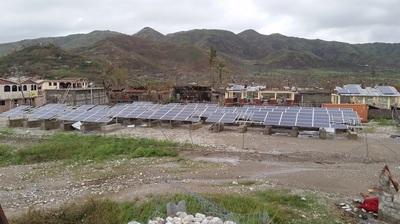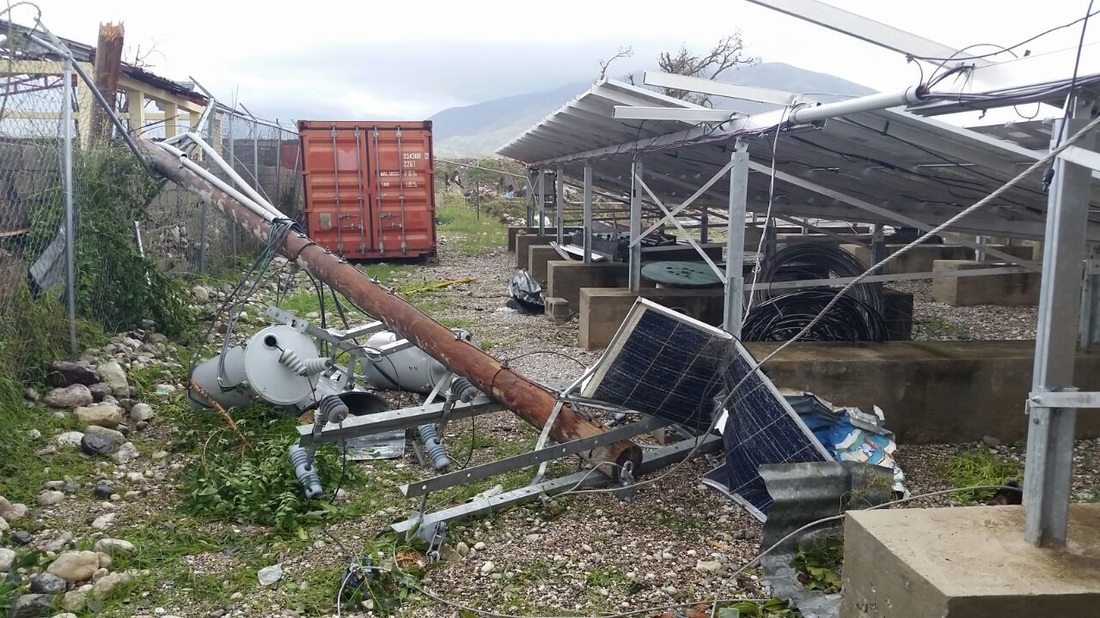Following is an overview of repair efforts to date for EarthSpark’s Haitian Microgrid. The overview was presented by Rachel McManus, executive director of EarthSpark, at the recent HOMER International Microgrid Conference 2016 in New York City.

EarthSpark’s Haitian microgrid lost about 40% of solar panels but the power electronics and battery bank were left unscathed.
Building and sustaining a microgrid takes a lot of planning for potential challenges such as transport of materials, payment schemes, community building, and maintenance. Even with the best planning, however, microgrids may encounter unexpected challenges, such as a devastating hurricane. EarthSpark‘s team recently learned this lesson in Haiti. EarthSpark, a nonprofit committed to eradicating energy poverty, built the Les Anglais microgrid. The microgrid, inaugurated in June 2015, provided 450 homes and businesses with full-time electricity.
“We need to be building sustainable, long-term infrastructure,” says McManus, “including sustainable energy services that can unlock economic potential with higher levels of power — so that we aren’t always just meeting basic needs in developing countries.”
For more than a year, the new microgrid’s customers had been saving 50-80% over their previous power costs — for kerosene lamps, third party phone charging, and generators. EarthSpark had signed a 9-year concession with the next town and had begun the process of community engagement and household mapping. The project was progressing well until the Hurricane Matthew hit Haiti in September of 2016.
As soon as the upcoming storm’s potential devastation was understood, the local EarthSpark team informed the community that the microgrid would be shut down and to charge their phones and radios before that occurred. The team sandbagged the generation site, shut off the grid, and found safe shelter for staff to wait out the hurricane.
After 3 days of no communication with the team in Haiti, EarthSpark began to receive reports of Hurricane Matthew’s damage. The microgrid lost about 40% of solar panels but the power electronics and battery bank were left unscathed. In the hierarchy of needs in the aftermath of the storm, electricity wasn’t high up on people’s list. Food, shelter, and clean water were more urgent.

Hurricane Matthew’s aftermath for EarthSpark’s Haitian microgrid
It was not back to square one for the EarthSpark team, but it wasn’t easy, either. Smaller and more decentralized solutions popped up overnight to address people’s energy basic energy needs: such as solar lanterns and small generators. The generation system could be up soon, but it would be 6-9 months before homes will be in place for the distribution system to be rebuilt.
“EarthSpark is working on getting our microgrid powering homes and businesses as and when the community rebuilds,” says McManus. “It’s not easy and there is a lot of risk involved, but our work also holds so much potential for not only solving energy access in Haiti but also unlocking deeper economic security and quality of life for the regions we serve.”
Go to EarthSpark’s blog for more information and to donate to EarthSpark’s Haiti work.

The wooden pole failure was because a bad Project design:
1) The wood isn’t so strong for support the two transformers in a high point > great momentum!
2) The pole was installed in a danger position: at very short distance from FV panels!
3) Best material for pole: Steel or reinforced concrete
A Hurricane should have been expected and engineered for as it’s a known fact Haiti is has a history of hurricanes.
The result of poor planning caused this loss.
My own central Illinois ground mount is engineered for 130MPH sustained wind which will Handel any local winds except for a direct it by a tornado path that’s less than one mile wide.